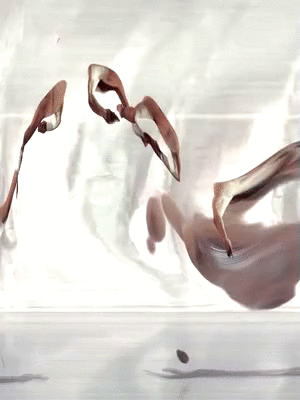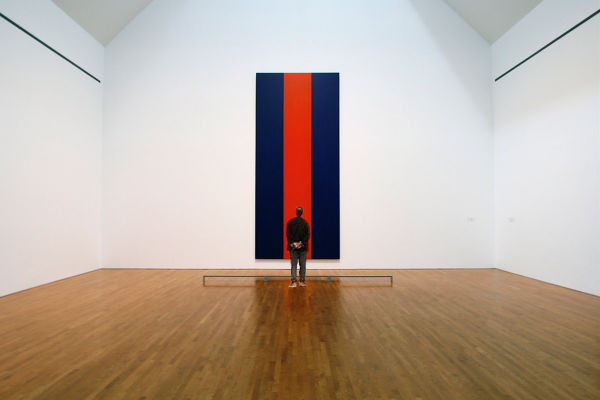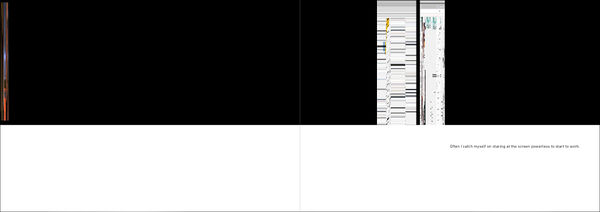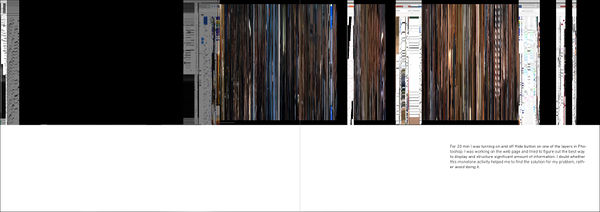User:SN/Graduate proposal: Difference between revisions
No edit summary |
No edit summary |
||
| (71 intermediate revisions by the same user not shown) | |||
| Line 1: | Line 1: | ||
<div style='width:900px;'> | <div style='width:900px;'> | ||
'''PREVIOUS PRACTICE''' | |||
During the two years in PZI my interests revolve around generative art, media specificities and distortion, its inevitability in any digital media. | |||
There are features common to all my projects: | |||
- works are based on code | |||
- works are about specificities of different media, transformed and applied one on another | |||
- set of rules directs the process | |||
- situations are created in which error could emerge | |||
[[User:SN/Untitled| Untitled, Chain reaction project]] | |||
[[User:SN/Sketch_004|Sketch#004, Boundaries of the Archive]] | |||
[[User:SN/Documentation Failure | Documentation Failure]] | |||
'''PROJECT''' | |||
“Technologies are artificial, but — paradox again — artificiality is natural to human beings.” (Ong, Orality and Litracy) | |||
Our relationships with the machines, the way technology is changing and overwriting us always were a theme for the discourse. The speculations on this topic can be found in popular culture, scientific articles, cultural and social studies. | |||
Every information technology brings a set of assumptions about the nature of knowledge and intelligence. It becomes subject to criticism, as it fights old established traditions and acquires to develop completely new skills. Nicholas Carr in the essay Is Google Making Us Stupid? wrote: “I’ve had an uncomfortable sense that someone, or something, has been tinkering with my brain, remapping the neural circuitry, reprogramming the memory. My mind isn’t going – so far as I can tell – but it’s changing. I’m not thinking the way I used to think.” | |||
Tatiana Chernigovskaya is a scientist in the field of neuroscience, psycholinguistics, and theory of mind in one of her lectures said: “We are what we remember”. She points out that memory is not a box with pictures or any other kind of information, not a library or database; our memory is the processes that take place in our brain. These processes are always new. They change who we are, and technology changes them. | |||
::... | ::... | ||
| Line 5: | Line 37: | ||
::[[File:day6.png|900px]] | ::[[File:day6.png|900px]] | ||
::''Recently I was reading an essay by Boris Groys. I caught myself | ::''Recently I was reading an essay by Boris Groys. I caught myself reading one paragraph for half an hour. I just couldn't understand what he was writing about. Words, sentences — all was clear, but the meaning was fading away from me.'' | ||
| Line 12: | Line 44: | ||
::[[File:day5.png|900px]] | ::[[File:day5.png|900px]] | ||
::''Often I catch myself | ::''Often I catch myself staring at the screen powerless to start to work.'' | ||
| Line 19: | Line 51: | ||
::[[File:day1.png|900px]] | ::[[File:day1.png|900px]] | ||
::'' | ::''his morning I spent a few hours checking my Instagram and Facebook accounts. I wrote a few comments and put some likes, read articles and watched some videos. I barely remember which photos I commented on and what my comments were about. For half an hour I was scrolling my Instagram feed without any attention to the content. Just repetitive movements of my finger on the surface of the screen and the void in my memory. Now it is 8 in the evening and I cannot remember any sufficient detail of what I read this morning. This activity didn't bring me joy or satisfaction, yet my morning starts and evening finishes with checking social networks. It became a reflex: you get up, brush your teeth and check the feeds on social networks, the mind is not involved.'' | ||
| Line 33: | Line 65: | ||
::[[File:day4.png|900px]] | ::[[File:day4.png|900px]] | ||
::''For 20 min I was turning on and off Hide button on one of the layers in Photoshop. I was working on | ::''For 20 min I was turning on and off the Hide button on one of the layers in Photoshop. I was working on a web page and tried to figure out the best way to display and structure a significant amount of information. I doubt whether this monotone activity helped me find the solution to my problem, rather it helped me avoid doing it.'' | ||
These notes I | These notes I took while dealing with the digital world. Smartphone and laptop have become an essential part of my life. I used to think that they helped me to expedite my work; apps with smart interfaces, plugins, and scripts that optimize my workflow. But at some moment these tools stopped to be just tools, I became dependent on them. They transform the way I work, think and feel.'' | ||
'''IDEA''' | '''IDEA''' | ||
In my graduation project, I continued the experiments with generative design that I began in the first year of my studies. In my intention was to gather and analyze data to reflect | |||
on the theme of the relations between technology and myself, find the best visual expression of the anxiety about losing myself in a digital routine. Taking facts and small things while working on my computer or interacting with my phone, I wanted to reflect on the feeling of being trapped in a digital void. | |||
I started to develop my project being very negative about the impact modern communication technology has on us. Nicholas Carr’s findings only strengthened my assumptions. Nevertheless, now I tend to be less negative. | |||
''' | '''FILM''' | ||
My final piece is a code based animation that recreates data I collect. I used a script that takes screenshots every 10 seconds. It consistently worked in the background while I was using my computer. Python code created “zips” based on these screenshots where black space stands for the time my computer was switched off. It changes as the new digital landscape changes my perception of time and space. | |||
'''INSPIRATION AND PROCESS''' | |||
One of the subjects of my research was code-based visual systems that I could implement into work with data. Slit scanning technique was one of them. | |||
[[File:Ec.gif|300px]] | [[File:Ec.gif|300px]] | ||
| Line 56: | Line 92: | ||
{{youtube|-4yVbPbJTHc}} | {{youtube|-4yVbPbJTHc}} | ||
{{vimeo| | {{vimeo|1398634}} | ||
Mood references | |||
{{youtube|uYr_SvIKKuI}} | |||
Michael Snow «The Central Region» | |||
{{vimeo|115693196}} | |||
[[File:Barnett_Newman.jpg|600px]] | |||
Barnett Newman works | |||
On the last stages of the project, I had few questions to answer. | |||
At first, I planned to make a book that would include 40 images and 40 notes that correspond to 40 days I was thinking, contemplating and analyzing my digital routine. I planned to make an voiceover based on my notes for video. These elements would dispose to speculation about the impact the technology has on us. | |||
[[File:P 1.jpg|600px]] | |||
[[File:P 2.jpg|600px]] | |||
The other direction ( that I actually chose) would be to exclude all the narrative from the piece and concentrate on the emotions I want to raise. Those are uncertainty, obscurity and melancholy. The animation would create the digital abstract landscape that would carry away in the new environment and evokes contemplation and meditation. | |||
I was playing around the levels of abstraction, velocity, and sound trying to be as minimal as possible in order to not wake the viewer from the meditation state. | |||
| Line 100: | Line 126: | ||
Nicholas Carr "The Shallows: How the Internet is Changing the Way We Think, Read and Remember." | Nicholas Carr "The Shallows: How the Internet is Changing the Way We Think, Read and Remember." | ||
Katherine Hayles "How We Became Posthuman." | |||
Katherine Hayles "How We Became Posthuman" | |||
Charlie Gere "Digital Culture" | Charlie Gere "Digital Culture." | ||
Michael Foucault "Technologies of the Self" | Michael Foucault "Technologies of the Self." | ||
Timothy Barker "Aesthetics of the Error" | Timothy Barker "Aesthetics of the Error." | ||
Rosa Menkman "The Glitch Momentum" | Rosa Menkman "The Glitch Momentum." | ||
Golan Levin "An Informal Catalogue of Slit-Scan Video Artworks and Research." | |||
Jos de Mul "The Work of Art in the Age of Digital Recombination." | |||
Lev Malovich "Post-media Aesthetics" | Lev Malovich "Post-media Aesthetics." | ||
Lev Malovich "The Language of New Media" | Lev Malovich "The Language of New Media." | ||
Mark | Mark Hansen "The new Philosophy of New Media." | ||
David Hopkins "After Modern Art" | David Hopkins "After Modern Art." | ||
</div> | </div> | ||
Latest revision as of 22:21, 18 June 2018
PREVIOUS PRACTICE
During the two years in PZI my interests revolve around generative art, media specificities and distortion, its inevitability in any digital media.
There are features common to all my projects:
- works are based on code
- works are about specificities of different media, transformed and applied one on another
- set of rules directs the process
- situations are created in which error could emerge
Untitled, Chain reaction project
Sketch#004, Boundaries of the Archive
PROJECT
“Technologies are artificial, but — paradox again — artificiality is natural to human beings.” (Ong, Orality and Litracy)
Our relationships with the machines, the way technology is changing and overwriting us always were a theme for the discourse. The speculations on this topic can be found in popular culture, scientific articles, cultural and social studies.
Every information technology brings a set of assumptions about the nature of knowledge and intelligence. It becomes subject to criticism, as it fights old established traditions and acquires to develop completely new skills. Nicholas Carr in the essay Is Google Making Us Stupid? wrote: “I’ve had an uncomfortable sense that someone, or something, has been tinkering with my brain, remapping the neural circuitry, reprogramming the memory. My mind isn’t going – so far as I can tell – but it’s changing. I’m not thinking the way I used to think.”
Tatiana Chernigovskaya is a scientist in the field of neuroscience, psycholinguistics, and theory of mind in one of her lectures said: “We are what we remember”. She points out that memory is not a box with pictures or any other kind of information, not a library or database; our memory is the processes that take place in our brain. These processes are always new. They change who we are, and technology changes them.
- ...
- Recently I was reading an essay by Boris Groys. I caught myself reading one paragraph for half an hour. I just couldn't understand what he was writing about. Words, sentences — all was clear, but the meaning was fading away from me.
- ....
- Often I catch myself staring at the screen powerless to start to work.
- ...
- his morning I spent a few hours checking my Instagram and Facebook accounts. I wrote a few comments and put some likes, read articles and watched some videos. I barely remember which photos I commented on and what my comments were about. For half an hour I was scrolling my Instagram feed without any attention to the content. Just repetitive movements of my finger on the surface of the screen and the void in my memory. Now it is 8 in the evening and I cannot remember any sufficient detail of what I read this morning. This activity didn't bring me joy or satisfaction, yet my morning starts and evening finishes with checking social networks. It became a reflex: you get up, brush your teeth and check the feeds on social networks, the mind is not involved.
- ....
- Today I printed out an entire ebook. I cannot concentrate while reading long texts on my Ipad. Reading from the screen takes too much time.
- ...
- For 20 min I was turning on and off the Hide button on one of the layers in Photoshop. I was working on a web page and tried to figure out the best way to display and structure a significant amount of information. I doubt whether this monotone activity helped me find the solution to my problem, rather it helped me avoid doing it.
These notes I took while dealing with the digital world. Smartphone and laptop have become an essential part of my life. I used to think that they helped me to expedite my work; apps with smart interfaces, plugins, and scripts that optimize my workflow. But at some moment these tools stopped to be just tools, I became dependent on them. They transform the way I work, think and feel.
IDEA
In my graduation project, I continued the experiments with generative design that I began in the first year of my studies. In my intention was to gather and analyze data to reflect on the theme of the relations between technology and myself, find the best visual expression of the anxiety about losing myself in a digital routine. Taking facts and small things while working on my computer or interacting with my phone, I wanted to reflect on the feeling of being trapped in a digital void.
I started to develop my project being very negative about the impact modern communication technology has on us. Nicholas Carr’s findings only strengthened my assumptions. Nevertheless, now I tend to be less negative.
FILM
My final piece is a code based animation that recreates data I collect. I used a script that takes screenshots every 10 seconds. It consistently worked in the background while I was using my computer. Python code created “zips” based on these screenshots where black space stands for the time my computer was switched off. It changes as the new digital landscape changes my perception of time and space.
INSPIRATION AND PROCESS
One of the subjects of my research was code-based visual systems that I could implement into work with data. Slit scanning technique was one of them.
Mood references
Michael Snow «The Central Region»
Barnett Newman works
On the last stages of the project, I had few questions to answer.
At first, I planned to make a book that would include 40 images and 40 notes that correspond to 40 days I was thinking, contemplating and analyzing my digital routine. I planned to make an voiceover based on my notes for video. These elements would dispose to speculation about the impact the technology has on us.
The other direction ( that I actually chose) would be to exclude all the narrative from the piece and concentrate on the emotions I want to raise. Those are uncertainty, obscurity and melancholy. The animation would create the digital abstract landscape that would carry away in the new environment and evokes contemplation and meditation.
I was playing around the levels of abstraction, velocity, and sound trying to be as minimal as possible in order to not wake the viewer from the meditation state.
References
Nicholas Carr "The Shallows: How the Internet is Changing the Way We Think, Read and Remember."
Katherine Hayles "How We Became Posthuman."
Charlie Gere "Digital Culture."
Michael Foucault "Technologies of the Self."
Timothy Barker "Aesthetics of the Error."
Rosa Menkman "The Glitch Momentum."
Golan Levin "An Informal Catalogue of Slit-Scan Video Artworks and Research."
Jos de Mul "The Work of Art in the Age of Digital Recombination."
Lev Malovich "Post-media Aesthetics."
Lev Malovich "The Language of New Media."
Mark Hansen "The new Philosophy of New Media."
David Hopkins "After Modern Art."









